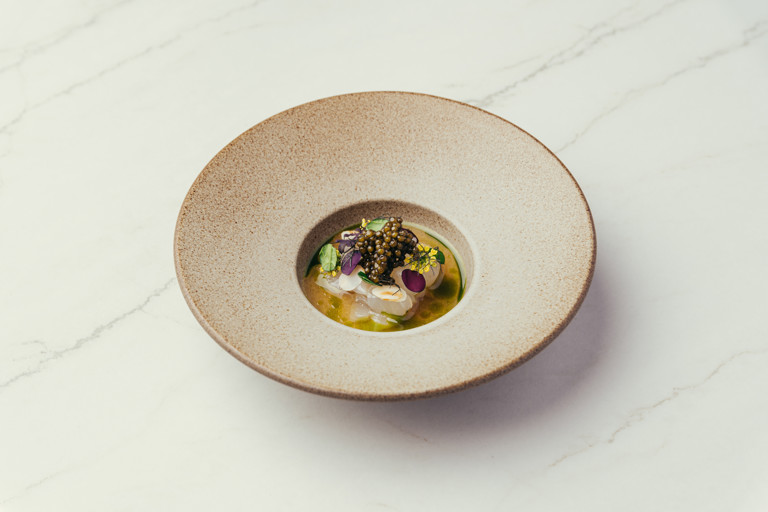Kombu-cured bream, shio koji, celeriac dashi
- medium
- 4
- 3 hours plus 48 hours for fermenting, dehydrating and smoking
This beautiful kombu-cured Japanese bream dish from Stuart Ralston involves fermenting celeriac for several days in shio koji, and making katsuobushi-inspired dried, smoked fish from sea bream. A lovely amalgamation of both British and Japanese ingredients and techniques.
Ingredients
Metric
Imperial
Shio koji celeriac
- 400g of dried rice koji
- 800ml of warm water
- 100g of salt
- 500g of celeriac, peeled and punched into 1 mm-thick discs
Bream 'katsuobushi'
- sea bream, bones and skin
Smoked apple vinegar
- 2 apples, quartered
- 300mm of apple cider vinegar
Wasabi leaf oil
- 200g of spinach
- 20g of wasabi leaves
- 5g of wasabi paste
- 200ml of rapeseed oil
Kombu-cured bream
- 1kg sea bream, skinned and filleted, skin and bones reserved
- 1l water
- 100g of salt
- 3 limes, zested and juiced, plus more lime juice as needed
- 100g of dried kombu, toasted
Garnish
- N25 caviar
- red butterfly sorrel
- wasabi leaves, cut into discus
- fennel flowers
- mustard leaf
- bronze sorrel
- bronze fennel
Equipment
- Dehydrator
- Thermomix
- Cold-smoker
Method
Combine the water and koji and allow to rehydrate for 20 minutes
- 400g of dried rice koji
- 800ml of warm water
Mix in the salt, and then use a stick blender to blend the mixture to a chunky paste
- 100g of salt
Cover the celeriac in the shio koji, and ferment at room temperature, 15–23°C, for 24 hours
- 500g of celeriac, peeled and punched into 1 mm-thick discs
Transfer the celeriac to the fridge and ferment for another 24 hours
Remove the celeriac from the shio koji, and transfer to a tray in the fridge to dry out until needed
For the bream 'katsuobushi', place the bones and skin from the bream on a perforated tray, and cold smoke for 1 hour
- sea bream, bones and skin
Transfer the smoked bream skin and bones to a dehydrator and dehydrate at 75°C overnight. Reserve for later
Cold smoke the apples on a perforated tray for 1 hour
- 2 apples, quartered
Transfer the apples to the apple cider vinegar, and leave to infuse for several hours
- 300mm of apple cider vinegar
Blend all the ingredients for the wasabi leaf oil together in a Thermomix, and heat to 70°C
- 200g of spinach
- 20g of wasabi leaves
- 5g of wasabi paste
- 200ml of rapeseed oil
Strain the oil through muslin, and let hang until all the oil has dripped through
Transfer the oil to a piping bag, and hang, point down, until the oil and water separate, and the oil rises to the top. This will take a couple hours
Once the oil has separated, carefully snip off the end of the piping bag and pour off just the water. Discard the water and set the oil aside
For the celeriac dashi, blend the water and celeriac together, then transfer to a pan
- 1.5g of celeriac, peeled and diced, 50g peel reserved
- 3l water
Add the salt, and bring to the boil. Simmer for 2 hours, then pass through a fine sieve
- 18g of salt
Preheat the oven to 200°C
Once the oven is at temperature, add the celeriac skin and roast until charred and dark, stirring occasionally
After passing the broth, add the onion and charred celeriac skin, and simmer the broth until reduced by half
- 1/2 red onion
Taste to adjust the seasoning, then pass through a fine sieve again
Mix together the water, salt, lime zest and kombu. Add the fish and cure for 15 minutes
- 1kg sea bream, skinned and filleted, skin and bones reserved
- 1l water
- 100g of salt
- 3 limes, zested and juiced, plus more lime juice as needed
- 100g of dried kombu, toasted
Meanwhile, warm the celeriac broth and, once at a simmer, add the bream ‘katsuobushi’. Strain off the katsuobushi, and then add a dash of the wasabi oil and smoked vinegar to taste. Adjust the seasoning as needed
Remove the fish from the brine, wash off and pat dry
Cut the bream into neat chunks, and season the fish with lime juice and salt to taste
Place some fish in the middle of each plate, and dress with the celeriac, herbs, caviar and top with the celeriac broth. There should be about 25g fish, 4g caviar and 50ml broth per person
- N25 caviar
- red butterfly sorrel
- wasabi leaves, cut into discus
- fennel flowers
- mustard leaf
- bronze sorrel
- bronze fennel
Get in touch
Please sign in or register to send a comment to Great British Chefs.


